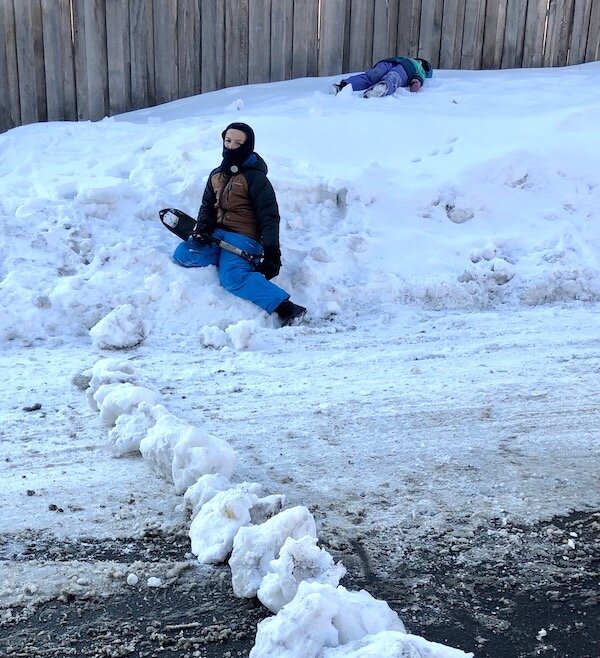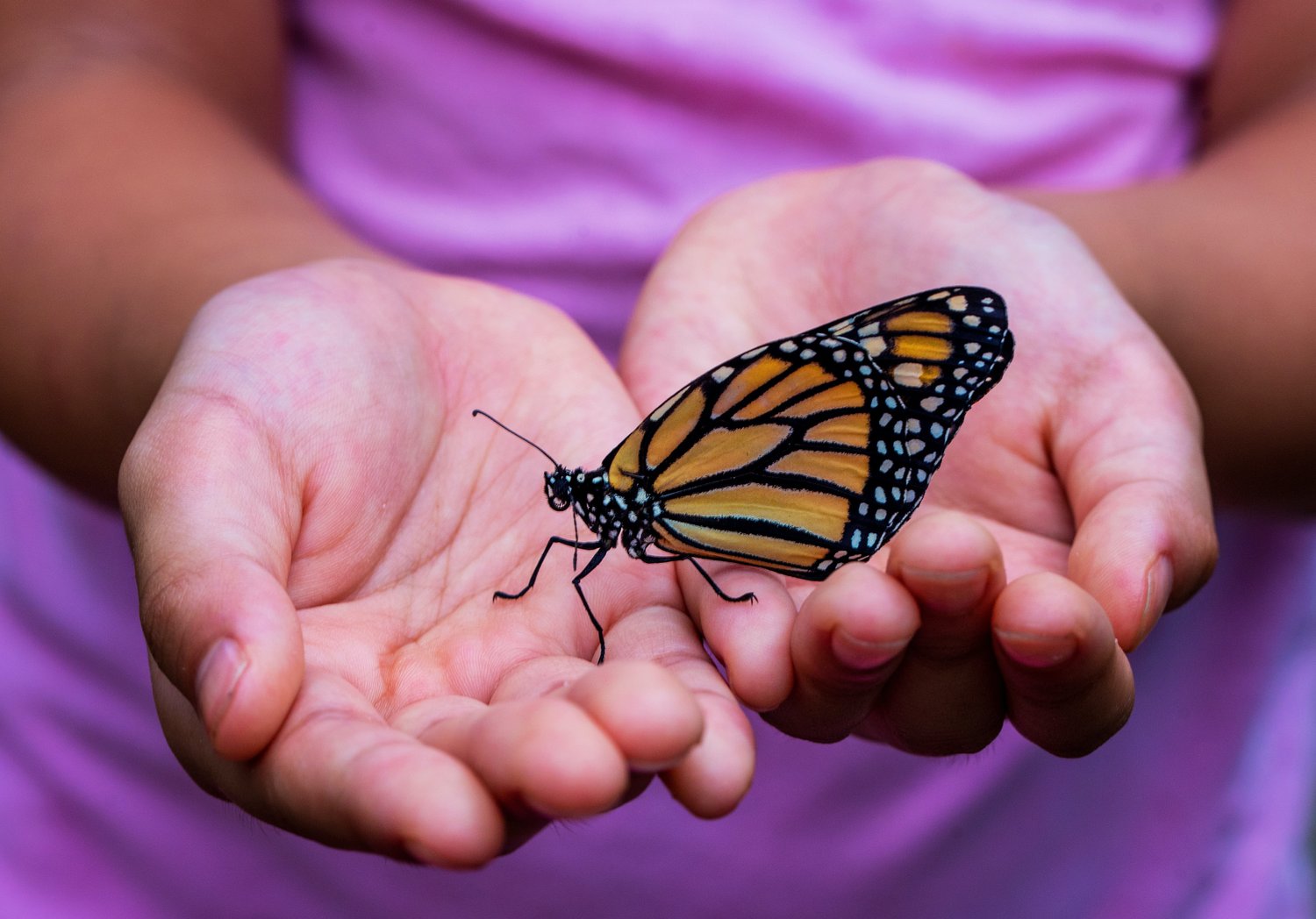Anna Sharratt, the founder of Free Forest School, takes you along on an outdoor romp with her kids on a chilly winter day…
If you have young kids in your life, there are many reasons you might want to consider making unstructured outdoor play a core of your routine. Being outdoors promotes calm and happiness, reducing stress and anxiety for both kids and adults. It gets us moving and exercising. Plus, research shows that nature play promotes academic learning as well as the key executive functions that help kids do well in school. Unstructured play doesn’t take a lot of planning, or time, or special equipment. Convinced yet?
But once you’re convinced to try it… What exactly should you do once you get outside?
Today, my kids and I headed out in the late afternoon to do who-knows-what. Lots of things happened, none of them planned. C’mon, I’ll show you.
In order to get my obstinate kids out the door, I tossed them a bone: Let’s go look for a snow bank to dig in! (They recently dug an epic snow cave with their cousins, so I knew this might be a hook…) I shoved a quick snack into their paws, and they bundled up in many layers (air temp 5, windchill -20, Brrr!) and headed out to find their tools of choice–a hammer and a small spade.
We set off toward a nearby dead end street and they found a big, crusty snow plow pile. I left them there digging while I walked around the block to warm up. By the time I’d returned, they’d already lost interest in the snow cave idea. Instead, they were engrossed in chipping out large ice chunks and making a barricade (sculpture?) stretching across the street.

One key to successful unstructured play is to try out a “lightest touch” approach. The less I can intervene, say, or do, the more they start to take the lead and get engaged in play. Choosing to take a walk around the block was a strategic choice to excuse myself at the start of their play. This way, they didn’t look to me for direction and I wasn’t tempted to guide them. There are often key “I’m bored” moments at the beginning when we as adults feel particularly tempted to provide direction.
So many of the settings our kids find themselves in are adult-led, and it can take some intentionality to shift that dynamic and create space for authentic play to emerge. My kids’ ages and the safety of the street allowed me to step away physically, but there are other ways to do this. You could start working on your own project nearby, do jumping jacks or stretches, pick up trash, walk to the end of the block and back, etc.
Back to my kids and the ice-strewn street. The part of me that delights in child-initiated work loved seeing the care, coordination, communication, and vision their project exemplified. How often do siblings work in perfect concert, respecting one another, toward a shared vision? But I knew my neighbors wouldn’t have the same appreciation for this project, so I reluctantly intervened. I named the awesome teamwork I saw happening, but also asked them to imagine how neighbors on that part of the street might feel about the barricade.
We agreed they could finish the project but they’d have to move the ice chunks before we left. They ended transporting the ice chunks back to the side of the road, then building ice sculptures atop some rotting wooden posts. My intervention had taken some wind out of their sails so I helped with the new effort for a while. Once they were engaged in the task, I quietly retreated and watched them work from a spot of late afternoon sunshine across the way.
When that was done, we wandered over to the park nearby. A camping trip game developed, and the kids found “tent sites” and set off to look for “wolves”. They ended up “harvesting ice” in a field, carefully slicing the crusty snow into circular pieces and lifting it out with the hammer. This was meticulous work, and they called me over to give me a lesson. By now, the sun was on its steady trajectory downward and the Fahrenheit was dropping, too. We soaked up a little more golden light as we trundled homeward, calm and satisfied.

Not every day goes so smoothly. My kids are typically impossible to get out of the house, and then impossible to get back in again. They get bored, hungry; they bicker. But I have learned a few subtle things over the years that seem to help:
-
Offer a simple hook. Find some compelling reason to get outdoors. But make sure it’s not too elaborate. For example, I suggested, on purpose, that we “look for a pile of snow for digging a snow cave” not “dig a big snow cave”. It gave us a reason to get out but kept expectations open-ended. Other examples I’ve used:
Let’s take a basket and look for treasures.
Let’s see if we can find puddles to jump in / ice to break.
-
Add simple tools or loose parts. Nothing special needed here; whatever the kids choose is fine. A bucket, a piece of rope, a shovel, a wagon, a piece of PVC pipe, a board, a piece of fabric, a net, a stick. These sorts of props can help awaken the imagination!
-
Make yourself scarce. Think about creative ways to get yourself out of the picture. Go to a space you feel comfortable giving your kids a little room to play, and find a way to occupy yourself. I’ve observed incredible unadulterated play / work using this principle. If you look busy, you can sort of melt into the landscape and they forget about you!
-
Lightest touch. Think before you intervene (unless it’s a true emergency!), and if you need to intervene, do it in a minimal way when possible. Sometimes a simple look is enough to redirect a child. When I have to intervene, I find the spell is broken a bit and I might need to subtly repair what I broke.
-
Play when invited, retreat when you can. My kids know from years of experience that I love watching them play more than anything, and they are used to having me be a quiet observer outdoors. Not every kid is going to be ready for so much autonomy, and that’s okay. If your little ones want you to play with them, give them the attention they are asking for, but do it in a way that lets them take the lead. If they deviate from typical ways of playing (they want to play catch with a soccer ball or climb up a slide) go with it. And when they are engaged and content, you can slowly retreat. Another good technique is an approach for when a child asks you to do something for them: I will intentionally do the task poorly, and they quickly take it over to show me how to do it.
-
Cover all their basic needs. Feed them snacks, bring water, make sure they have extra layers. No excuses, we’re staying out!
So, what’s the plan when you head outdoors with your kids? The plan is to not have a plan. The plan is to be prepared, with warm layers, a full belly and an open mindset. The plan is to make time to be outside together, whatever adventures they may dream up.




